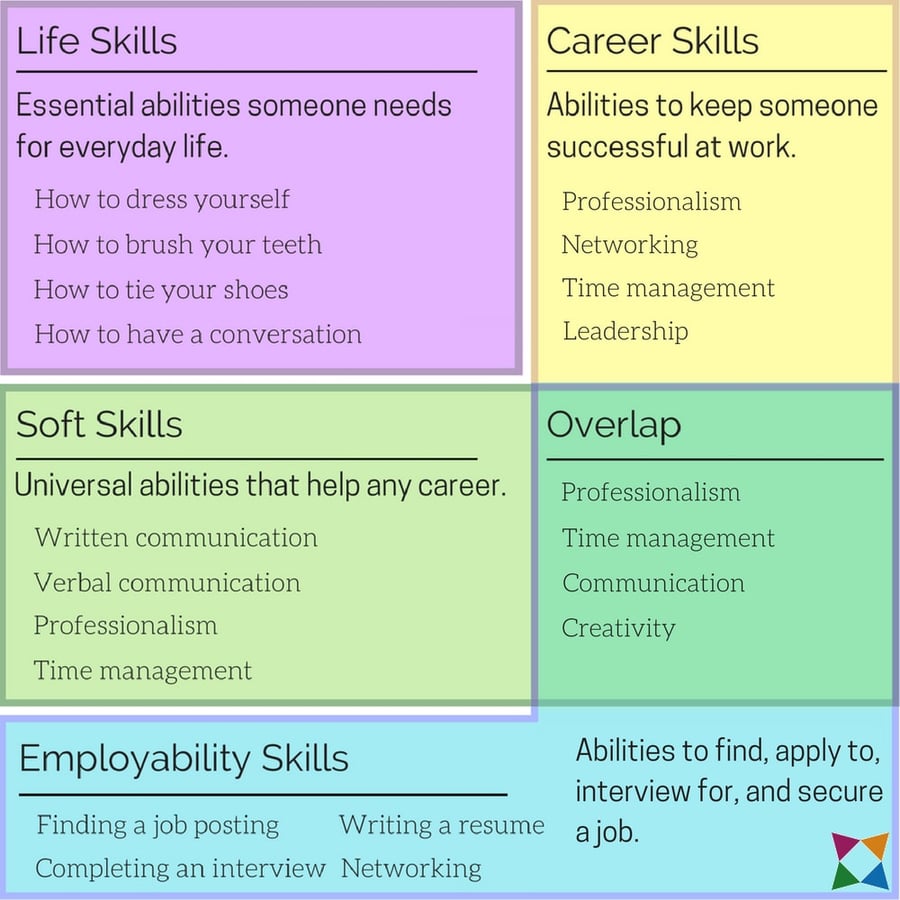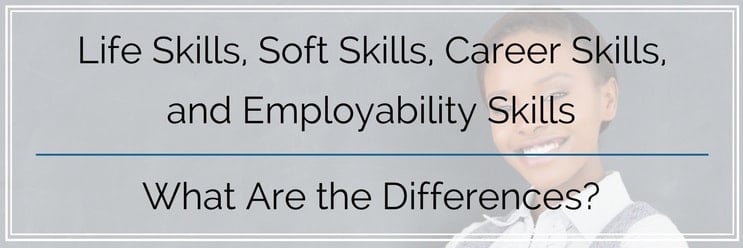Career Readiness | Employability Skills | Soft Skills | 21st Century Skills
Life Skills vs. Soft Skills vs. Career Skills vs. Employability Skills — What Are the Differences?
Today, teachers throughout the United States are focusing more on prepping their students for their future careers.
Some teachers do this by creating a life skills curriculum. Others make a soft skills curriculum. Sometimes, they made a career skills or employability skills curriculum.
Surprisingly, all of these teachers mean the same thing – they just have different ways of saying it!
That means some wires got crossed somewhere.
“Life skills” is also used by special education teachers. “Soft skills” may refer to college readiness. Sometimes “career skills” aren’t meant for a career at all – they just help students get through a job interview.
So what do all of these mean? Are life skills the same concepts as career skills? Do soft skills and employability skills overlap?
To answer those questions, we’ll take a look at all four of these skills categories and what makes them unique.

Now, let's take a look at each category of skills separately to really dive into what they mean.
What Are Life Skills?

“Life skills” refers to a set of fundamental abilities that someone needs to get through modern, everyday living.
Most often, life skills are taught in special education courses.
The most popular life skills are ones that most adults take for granted:
- How to dress yourself
- How to brush your teeth
- How to tie your shoes
- How to have a conversation
Unfortunately, these skills aren’t easy to teach. Despite the fact that functioning members of society can perform any of these skills at a moment’s notice, teaching them to someone else – especially someone with a learning disability or other mental obstacle – is extraordinarily difficult.
To make matters worse, there are practically zero options for special education instructors to help with teaching life skills.
Unless a teacher has a colleague who’s willing to help, they’re on their own.
This is one of the big reasons why you hear about special education teachers “burning out.” It’s not about a teacher’s ability to empathize with her students – it’s about the challenge and repetition of teaching these life skills.
(Let’s be honest – the poor paycheck doesn’t help either.)
For these reasons, it’s important to remember that the phrase “life skills” is distinct from the other terms in this blog.
Life skills might include some foundational principles of the other skills – like how to shake someone’s hand – but they focus on someone’s day-to-day living.
In that respect, “life skills” describes a set of teaching challenges that are fundamentally different from the other terms on this list.
What Are Soft Skills?

“Soft skills” are workplace abilities that someone can use in any career. They’re called “soft” because they’re not skills that define someone’s work, like programming or repairing a car engine.
Instead, soft skills apply to everyone from an entry-level employee all the way to the CEO.
Some popular soft skills include:
- Written communication
- Verbal communication
- Professionalism
- Time management
These skills are ones that no one really “masters.” In fact, they’re often subjective with few tried-and-true methods to evaluate whether someone is actually good at them.
Most of the time, you can tell someone has a good grasp of soft skills when you experience it. That could come as early as reading someone’s cover letter on their job application.
It could also come as late as the first time they run a meeting in your office.
Regardless, almost everyone has opportunities to improve their soft skills over time through practice.
When students learn about them in the workplace, they have a leg up over everyone else in their age range.
The worst scenario for soft skills is that students don’t experience them until after they’ve started their careers.
What Are Employability Skills?

The term “employability skills” refers to the abilities someone needs to find a job, apply to it, interview for it, and start working.
Sometimes, teachers talk about employability skills in terms of soft skills or career skills, which makes this concept a little murky.
Employability skills education often includes:
- Finding a job posting
- Writing a resume
- Completing an interview
- Networking
These four skills are crucial to starting a career in any capacity. Whether a student ends up being an engineer or a journalist, they need to know these skills (and more).
The idea is that these skills will pay throughout a student’s life. These skills will help students start a career of course, but they’ll also help students choose the direction of their career in the future.
They may spend four years at their first job. Then, they may find a better opportunity because they’ve learned, practiced, and honed their employability skills.
That system can repeat frequently in someone’s life as it’s becoming more common for employees to seek opportunities at other companies instead of internal promotion.
With that in mind, employability skills empower students for the rest of their lives.
What Are Career Skills?

“Career skills” are abilities that keep someone successful in a job or company, especially as a person gets promoted.
Depending on who you ask, a career skills curriculum may mean teaching more or fewer skills than a soft skills curriculum.
But most of the time, career skills cover the abilities someone needs to succeed in a position, including:
- Professionalism
- Networking
- Time management
- Leadership
That’s why career skills, employability skills, and soft skills overlap so much. Some teachers may say that interviewing techniques are a part of soft skills, while others insist that they’re only related to career skills.
Specifically, career skills all relate to the workplace and how students can perform within it. A lot of these skills rely on behavior, as opposed to quantifiable skills, which makes them difficult to experience for students.
Many teachers take this opportunity to have students role-play together. That may take the form of a mock job interview, a fake meeting, or some other well-known part of experiencing a career.
The more students can practice, the more they can prepare for these events in their professional lives.
Granted, students may not use these skills for years.
While career skills are popular curriculum topics for middle school or even elementary school students, high school students will probably get the most value from learning them since they’re going to start their careers sooner than other grade levels.
You can always make the case that it’s never too early to teach behavioral skills, especially professionalism.
So there’s just one last question to answer — how do you start teaching these skills when you’re responsible for them?
Start Teaching Soft, Career, & Employability Skills Today
In this article, you've learned about the differences between life skills, soft skills, career skills, and employability skills. Each of sets of skills are important for students, but how do you go about teaching them to your students?
Unfortunately, there isn't a lot of curriculum available for life skills students. However, if you want to teach soft, career, and employability skills, you can cover all three with a comprehensive career readiness curriculum!
When you choose a CTE solution like iCEV, you gain access to an extensive curriculum with pre-built lesson plans, interactive activities, automatically graded assessments, and more.
To discover if iCEV is right for your program, visit the Middle School Digital Literacy and Career Exploration curriculum page. You'll learn more about the courses you can teach with iCEV to decide if it's suitable for your students.

